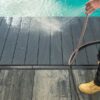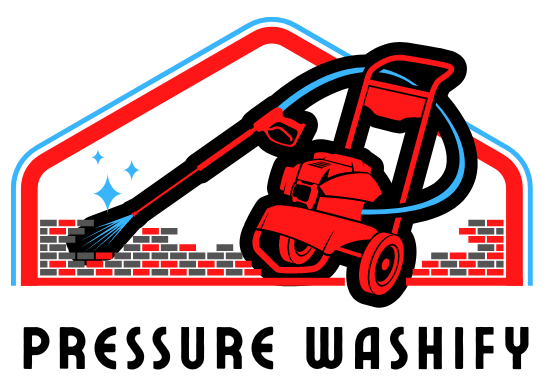Affiliate Disclaimer: This post may contain affiliate links, meaning we get a commission if you decide to make a purchase through our links, at no extra cost to you.
Pressure washing can add tremendous value to your home, making it look like new and increasing curb appeal, but how long does it take to pressure wash a house? The answer depends on the size of the home, type of surface, and the equipment and products you have available. In this article, we’ll discuss the factors that influence how long it takes to pressure wash a house, and provide some tips on how you can get the job done quickly and efficiently.
Time Is Money: What Affects How Long It Takes to Pressure Wash Your House
Size of the house
A larger home will obviously take longer to pressure wash than a smaller one. The more square feet of surface area you need to clean, the more time it will take. For example, a 1,500-square-foot house with a flat roof should take about two hours to clean using standard equipment and supplies. A 3,000 square foot home with two levels might require four hours or more.
Number of stories
A two-story home will take longer to pressure wash than a one-story home. Each level of a home will require more time and effort to clean. The amount of pressure needed to reach the top floor may also be greater than what is required for lower levels.
Type of roofing
Roofing materials that are more porous, such as asphalt shingles or cedar shakes, will take longer to clean than those with less porosity like granules or tiles.

Exterior finish
A home with brick or stone exterior will take longer to pressure wash than a home with vinyl siding. This is because brick and stone have pores between the individual stones.
Porch and deck areas
Pressure washing these areas will add to the overall time required.
Presence of trees and shrubs
These can act as barriers, making it take longer to reach all sides of the house.
Type of pressure washer
A higher-powered pressure washer will obviously get the job done quicker than a lower-powered one. Gas pressure washers are typically more higher powered than electric pressure washers.
The condition of your siding
If your siding is covered in dirt, pollen, or other debris, it will take longer to clean than if it’s in good condition.
Approximate Time Required to Pressure Wash a House
| House Size (Sq. Ft.) | Construction Material | Approximate Time (Hours) |
|---|---|---|
| 1,000 – 1,500 | Wood | 2 – 4 |
| 1,000 – 1,500 | Vinyl/Aluminum siding | 1.5 – 3 |
| 1,000 – 1,500 | Brick/Stone | 3 – 5 |
| 1,500 – 2,500 | Wood | 4 – 6 |
| 1,500 – 2,500 | Vinyl/Aluminum siding | 2.5 – 4 |
| 1,500 – 2,500 | Brick/Stone | 4 – 7 |
| 2,500 – 3,500 | Wood | 6 – 8 |
| 2,500 – 3,500 | Vinyl/Aluminum siding | 4 – 6 |
| 2,500 – 3,500 | Brick/Stone | 6 – 10 |
Please note that these are approximate values and may vary depending on various factors such as the condition of the house, type of pressure washer used, and the experience of the operator.
Time-Saving Tips for Pressure Washing Your House in Half the Time
Gather your materials in advance
One of the biggest time-wasters when pressure washing a house is having to constantly stop to gather materials. The best way to make sure you have everything you need at hand is to plan beforehand and create a checklist with all the materials you will need for your job. This will make it easy for you to ensure that you have everything on hand, and avoid any unwanted delays when pressure washing a house.
What You’ll Need:
- Pressure washer
- Hose
- Soap or detergent Brushes (long-handled scrub brushes are good for cleaning siding)
- Bucket of water or soapy water (if using soap)
- Rags or sponges (for applying soap or rinsing off soiled areas)
- Ladder/scaffold (optional)
- Work gloves
- Safety glasses
- Protective clothing (recommended but optional)
- Paper towels/rags Tape (optional)
If you’re pressure washing a driveway or patio, for example, then a long-handled scrub brush would be an asset. If you’re pressure washing windows, then either paper towels or sponges would be helpful.
Consider what kind of work surface is involved before buying supplies such as brushes and rags – if your project involves cleaning large surfaces like siding, buy extra rags so that one can be dedicated to each part of your home or building. You might also want to consider renting a ladder or scaffold if it’s necessary to reach high places safely.
Do a preliminary cleaning
The first step is to remove any dirt, dust or debris that could clog up the pressure washer. Using a broom or a rake, sweep any of these particles away from the area you will be cleaning. Next, use a garden hose with the spray nozzle attachment and spray down the surface you will be cleaning. This will get rid of additional dirt and debris and allow for better penetration and save significant time when using your pressure washer.
Work in sections
Trying to pressure wash an entire house in one go is a recipe for disaster. Not only will it take forever, but you’re likely to miss spots or apply too much pressure in some areas. Pressure washing can be dangerous if you don’t know what you’re doing.
To reduce the risk, don’t try to pressure wash an entire home in one go. Instead, work on one section at a time and make sure that your hose is fully extended so that you have the maximum amount of reach. If the water pressure drops off before you get to the end of your hose, move closer to where you started and begin again from there.
Use the right pressure and nozzle
Applying too much pressure or using the wrong nozzle can damage your siding or paintwork. If you’re not sure what settings to use, start with a lower pressure and move up until you find the sweet spot. As a general rule of thumb, wider nozzles are better for large areas while narrower ones are better for getting into tight spaces or corners.
Depending on the type of surface you’re going to be washing, you’ll need to adjust the pressure setting on your machine. A higher setting is needed for tougher jobs like removing graffiti or cleaning concrete, while a lower setting is better for delicate surfaces. However take caution with higher pressure settings because a high pressure stream of water can easily strip paint off if you’re not careful. Selecting the right one will help you get the job done more quickly.
Using the correct nozzle and pressure setting can clean surfaces quickly and save you precious time.
Rinse thoroughly
The rinsing step is important to ensure that any soap or chemical residue left over on the surface is removed. If you don’t rinse properly, this could lead to staining or etching of the surface. There are several methods for rinsing a pressure washing surface, and it depends on your needs and preferences. Hoses with special nozzles can be used to flush the area from a distance and avoid standing water.
Follow proper techniques
Proper techniques for pressure washing a house cannot only ensure a thorough cleaning, but can also save time. When it comes to pressure washing a house, it’s important to start with the right tools and equipment, including a pressure washer with the appropriate pressure level for the job. Working in sections and using overlapping strokes can also save time and prevent missed spots or streaks.
And by using the correct nozzle and working from the top down, cleaners can cover more surface area and avoid unnecessary backtracking. Additionally, pre-treating heavily soiled areas with a cleaning solution beforehand can help to loosen dirt and grime, further reducing cleaning time. By following these proper techniques, homeowners and professional cleaners alike can ensure a job well done, and save time in the process.

Conclusion
How long does it take to pressure wash a driveway can depend on the size and condition of the driveway. The whole process can take anywhere from a few minutes to an hour or more. It is essential to adhere to safety guidelines when operating a pressure washer.
Pressure washing can be a great way to make an old driveway look like new again. With the right technique, the right equipment, and ample preparation, pressure washing a driveway can be a relatively quick and easy job.
Read more about how long it takes to wash a driveway.









